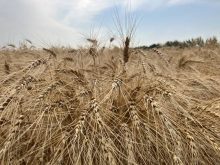Rises in average farmland values in Ontario, Manitoba and Saskatchewan jumped out ahead of Canada’s national average value, which itself rose at its fastest rate in years during the first half of 2012, according to Canada’s federal farm lender.
Farm Credit Canada on Tuesday rolled out the fall edition of its twice-yearly Farmland Values report, which tracks changes in farmland values across Canada between Jan. 1 and June 30 each year by appraising 245 benchmark properties coast to coast.
Measuring only percentage increases or decreases — rather than dollars per acre, which would vary widely between provinces and regions — Tuesday’s report found the average value of Canadian farmland rose 8.6 per cent in that period.
Read Also

U.S. grains: Corn, wheat ease after gains driven by Black Sea jitters
Chicago | Reuters – U.S. corn futures fell on Wednesday and wheat futures also dipped as fears eased about a…
The latest average national increase is Canada’s highest six-month jump since FCC began reporting on farmland values in 1984, and beats the 7.7 per cent increase in the second half of 2008, the lender said.
“High-quality farmland suitable for specialty crops continued to be in strong demand,” Michael Hoffort, FCC’s senior vice-president of portfolio and credit risk, said in a release.
“Consolidation of farms in some provinces is an ongoing trend as producers seek to increase their land base and take advantage of efficiencies.”
By comparison, the average value of Ontario farmland jumped 16.3 per cent between the end of 2011 and the end of June. Manitoba and Saskatchewan reported average-value increases of 10.3 and 9.1 per cent respectively.
Ontario’s land values reflect a sellers’ market, with an “unprecedented” number of sales in some areas of the province, especially in its southwestern, central and eastern regions, FCC said. The impact of the summer’s drought “will be monitored in future reports.”
Demand for Ontario land remained high from dairy producers and large intensive livestock operations, FCC said. Interest in prime vegetable land has spurred some southern Ontario farmers to sell rather than rent, while landlords provincewide make the same decision.
“This increased supply of land for sale could eventually help stabilize the market,” FCC said of Ontario, where values rose 7.2 per cent and 6.6 per cent in the previous two reporting periods.
In Manitoba, the increase was seen to come mainly from grain- and specialty crop-producing areas, which “benefited from good harvest conditions in the fall of 2011, and an early start to spring seeding.”
Manitoba’s southeast, however, saw the province’s “most significant increase in value” on demand from supply-managed sectors, the grain sector and rural residential buyers.
Saskatchewan’s 9.1 per cent gain, based on higher land prices through the “majority” of the province, followed increases of 10.1 and 11.6 per cent in the previous two reporting periods, FCC said.
“Overall optimism” and low interest rates find some Saskatchewan farmers looking to expand and renters seeking to buy their landlords’ land “before it sold to someone else.” Others considered selling land to get in on “the highest prices in recent history.”
“While interest rates will undoubtedly increase at some point, the key interest rate of the Bank of Canada is forecast to remain low into 2013, due to the uncertainty around the world economy,” FCC’s chief agricultural economist J.P. Gervais said in Tuesday’s release.
Land consolidation
Quebec booked the next highest Jan. 1-to-June 30 increase in average farmland values, at 6.7 per cent, continuing the province’s 28-year streak with no decrease in those values.
“The most important increases were observed in the cash crop sector, as confirmed by transactions for land parcels of all sizes,” FCC said of Quebec. Higher corn and soybean prices, strong demand, and low interest rates factored into the increases, the lender added, noting this summer’s drought in northwestern Quebec will be monitored.
Alberta’s average farmland values in FCC’s study saw an average increase of 5.7 per cent, coming mainly from the province’s northern, central and irrigated southern regions. Values in the province’s northwestern Peace region held stable, “possibly in response to concerns about moisture conditions.”
Average values in Prince Edward Island rose 3.1 per cent during the same period, followed by Nova Scotia at 2.8 per cent. Farmland values in New Brunswick and Newfoundland and Labrador went unchanged over the same period.
The Newfoundland and Labrador government continued to buy land with farming potential through its Land Consolidation program, which aims to lease such parcels back to active farms. Reportedly, FCC said, that program pays prices above the usual market prices for typical farmland.
Average farmland values in British Columbia slipped by 0.3 per cent over the same six months, following a 0.2 per cent increase in the previous period.
Demand from “lifestyle” buyers appeared to go soft in many areas of B.C., although fruit producers spurred strong demand in the south Okanagan and strong blueberry prices supported demand in the Lower Mainland.
Generally, a rising land market can be a good or bad thing depending on the “maturity” of a farmer’s business, and should be considered in terms of his or her growth strategy, FCC said.
“It can mean looking at different rent or lease options for those who would otherwise buy land, or it can improve equity for those producers who already own land,” Hoffort said.
Related stories:
Prairie farmland values soar as growers expand, Sept. 11, 2012
Sask. leads rise in Canadian farmland values, April 16, 2012














